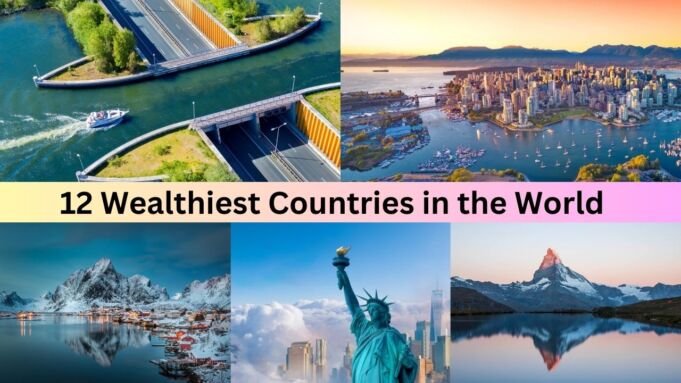The ranking of the world’s wealthiest countries varies depending on the criteria used, such as GDP per capita, purchasing power parity (PPP), or total GDP. For this essay, let us focus on GDP per capita because it provides an indication of a country’s average wealth per person, as well as insight into its residents’ standard of living and economic prosperity. Here are 12 of the Wealthiest Countries in the World by GDP per capita.
12 Wealthiest Countries in the World by Per Capita Net Worth
When determining the world’s wealthiest countries by per capita net worth, the emphasis changes to the average wealth possessed by each individual in these countries, taking into consideration assets such as property, cash, investments, and so on, minus any debt. This statistic provides a holistic assessment of citizens’ economic well-being that goes beyond income or GDP. Here are 12 of the world’s wealthiest countries in terms of per capita net worth.
1. Luxembourg

Luxembourg stands out for its tremendous wealth per capita, owing to a powerful combination of a strong banking sector, solid investment funds, and high levels of savings among its citizens.
Luxembourg offers castles and picturesque scenery, as well as cultural festivals and gastronomic specialties. Alternatively, you might just open an offshore account with one of the country’s banks and never return. It would be a pity because the tiny nation of about 650,000 people, located in the center of Europe, has plenty to offer both tourists and locals. Luxembourg devotes a significant portion of its riches to providing better housing, healthcare, and education to its citizens, who by far have the greatest quality of living in the Eurozone.
While the global financial crisis and efforts from the EU and OECD to eliminate banking secrecy may have had little impact on Luxembourg’s economy, the coronavirus pandemic prompted numerous enterprises to liquidate, resulting in job losses. Nonetheless, the country fared better than most of its European neighbors during the pandemic, with its economy rebounding from -0.9% growth in 2020 to more than 7% in 2021.
Unfortunately, due to high-interest rates, the war in Ukraine, and a broader deterioration of economic conditions in the Eurozone, that recovery did not continue long: the GDP grew by just 1.3% in 2022 and fell by 0.4% last year. Still, slow economic growth may not be worth whining about. Luxembourg surpassed $100,000 per capita GDP in 2014 and hasn’t looked back since.
2. Switzerland

Switzerland is responsible for numerous notable innovations, including white chocolate, the bobsleigh, the Swiss Army knife, the computer mouse, the immersion blender, velcro, and LSD. This country of approximately 8.8 million people derives much of its riches from banking and insurance services, tourism, and the export of pharmaceuticals, jewels, precious metals, precision instruments (such as watches), and machinery.
According to Credit Suisse’s 2023 Global Wealth Report, Switzerland once again ranked first in terms of average wealth per adult, with $685,230. Furthermore, almost one out of every six adults holds assets worth more than one million US dollars. Is it any surprise that Switzerland has the highest density of millionaires in the world?
But does this mean the Swiss have no economic concerns at all? Not only did the pandemic have a severe economic impact, but due to the country’s reliance on Russian oil and gas supplies, the war in Ukraine caused an increase in energy prices and supply chain disruptions. Furthermore, Credit Suisse was on the verge of bankruptcy in 2022 before being saved by its long-time rival, UBS Group, thanks to a government-engineered bailout. The collapse of Credit Suisse has jolted the country, undermining Switzerland’s position as a secure and dependable global banking center.
3. Norway

Norway’s wealth is greatly bolstered by the world’s largest sovereign wealth fund, which is funded by oil and gas production income. Oil has powered Norway‘s economy since the late 1960s, when huge offshore reserves were discovered. As Western Europe’s largest petroleum producer, the country has benefited from rising prices for decades.
Until it didn’t: prices plummeted in early 2020, followed by a global pandemic, sending the krone into freefall. In the second quarter of that year, Norwegian GDP decreased by 6.3%, the steepest drop in half a century and probably since World War 2.
Does this imply that Norwegians become much less rich than they were before the pandemic? Certainly not. Following the initial shock, the economy steadily reduced its losses and recovered.
Furthermore, in the event of an unforeseen economic disaster, Norwegians may always rely on the world’s largest sovereign wealth fund, worth $1.3 trillion. Furthermore, unlike many other wealthy countries, Norway’s high per capita GDP estimates provide a pretty accurate depiction of the ordinary person’s economic well-being. The country has one of the lowest income inequality gaps in the world.
4. United States

The United States, with its broad and inventive economy, has a considerable wealth distribution among its people. The strength of the stock market, real estate, and technological sectors all contribute to its people’s high net worth.
If you’re curious about GDP per capita At the outset, the United States is unquestionably among the top ten economies in terms of GDP per capita PPP, albeit in a lower position. Along with being a powerful economic force, America is also propelled by its military might.
5. Australia

Australia’s riches are fueled by its vast natural resources, robust real estate market, and significant investment in human capital. Australians benefit from an economy that is both resource-rich and technologically sophisticated.
Australia’s GDP is primarily driven by agriculture, industry, and services. The services sector accounts for 62 percent of the country’s GDP. Mining contributes around 10% of Australia’s GDP and 69% of its overall export revenue. Although Australia is the sixth largest country by geography, agriculture accounts for only 3.1% of its GDP.
6. Canada

Canada’s per capita wealth is sustained by a combination of natural resources, a booming service industry, and a robust property market. Canadians enjoy a good standard of living and have access to a wide range of social services.
Canada has a well-developed energy extraction industry and the world’s third-largest proven oil reserves. Canada also boasts excellent industrial and service industries, which are primarily concentrated in urban regions along the United States border.
Because of Canada’s free trade agreement with the United States, three-quarters of Canadian exports go to the U.S. market annually. Because of its tight relations with the United States, Canada has grown in lockstep with the world’s greatest economy.
7. Sweden

Sweden combines a strong economy with a comprehensive social system, resulting in high levels of wealth for its residents. The country’s emphasis on innovation, education, and sustainability boosts its economic development.
Sweden’s economy is competitive, with a high quality of life a balance of free entrepreneurship, and a strong social welfare state. Sweden’s manufacturing industry is strongly reliant on foreign exports, particularly machinery, automobiles, and telecommunications.
Sweden has welcomed a high number of new immigrants, creating a short- to medium-term challenge in integrating them into Swedish society and the labor market.
8. Denmark

Denmark’s economic model combines high levels of social welfare with a competitive capitalist economy, yielding high per capita wealth. Danes benefit from great social services, a robust educational system, and a high standard of living.
According to the Global Peace Index, Denmark is the world’s second safest country, and Numbeo’s Quality of Life Index ranks the Scandinavian country fourth in terms of living standards. It produces its own energy and exports it to European countries. Although services account for 67% of Denmark’s GDP, the country is well-known for its pharmaceutical, industrial, and electrical machinery output.
9. Singapore

Singapore, Asia’s richest nation, is frequently regarded as an international financial center. Singapore has a highly developed market economy, with an average income of $91,000. Historically, the nation’s strong average annual growth rates of around 6% between 1965 and 1995 were powered by significant entrepôt commerce. Singapore’s GDP growth rate is predicted to range between 0.5% and 2.5% in 2023.
Major agencies have given Singapore a AAA credit rating, reflecting its robust financial position and potential to attract huge sums of international investment. The city-state is more competitive because of its strategic position, highly skilled workforce, low tax rates, cutting-edge infrastructure, and effective anti-corruption policies. In addition, it holds the world’s ninth-largest foreign reserves. Its focus on healthcare, education, and income equality has helped it rank ninth on the Human Development Index and fourth among the world’s most competitive economies.
10. Netherlands

The Netherlands has a highly developed economy that is heavily reliant on international trade, innovative technology, and a high-quality social welfare system, all of which contribute to its residents’ wealth.
The Netherlands is a significant commercial transportation center that also produces some industrial goods and extracts and processes petroleum. It has a highly developed agriculture sector and ranks as the world’s second-largest agricultural exporter. The Netherlands has a large financial services sector that engages in asset pooling and is sponsored by the Dutch Ministry of Finance.
11. Austria

Austria has a high level of living due to its well-developed social market economy, strong industrial sector, and solid social welfare system. Its advantageous location in Europe contributes to its economic development.
Austria’s overall wealth is $1.79 trillion, with a wealth per adult of $245,225 as of 2022. Austria has a per capita GDP of $70,821, making it one of the world’s richest countries in terms of net worth.
12. Germany

Germany’s economy, the largest in Europe, is propelled by robust industrial production, a highly skilled labor population, and a massive capital stock. Germans have a high level of wealth per capita thanks to the country’s economic policies and social welfare system.
Germany is a leading exporter of automobiles, machinery, chemicals, and other manufactured goods, with a highly skilled workforce. However, Germany confronts some demographic barriers to economic progress. Its low birth rate makes replacing its aging workforce more challenging, while its large net immigration burdens its social assistance system.
These countries demonstrate how varied economies, solid social services, and an emphasis on innovation and education can lead to high levels of wealth per capita. However, it is crucial to realize that net worth varies greatly across countries, and these averages may not accurately reflect the distribution of wealth among all citizens.
Frequently Asked Questions (FAQs) about the Wealthiest Countries in the World
Here you can find a few commonly asked questions. Let’s check them out.
How is a country’s wealth measured?
A country’s wealth is commonly measured by its Gross Domestic Product (GDP) per capita, which divides the nation’s gross domestic product by its population. This metric provides an average economic output per person, indicating the standard of living and prosperity of the country’s residents.
Which country is considered the wealthiest in the world?
Luxembourg often tops the list of the wealthiest countries in the world when considering GDP per capita. Its robust financial sector and high standard of living contribute to its leading position.
Are the wealthiest countries also the largest economies?
Not necessarily. While some of the world’s largest economies like the United States and China have significant wealth, the wealthiest countries by GDP per capita are often smaller nations with specialized economies, such as Luxembourg and Switzerland.
What factors contribute to a country’s wealth?
Several factors contribute to a country’s wealth, including natural resources, industry diversity, technological innovation, education, political stability, and economic policies that encourage investment and trade.
How does the wealth of a country affect its citizens?
The wealth of a country can significantly impact its citizens’ quality of life, including access to healthcare, education, infrastructure, and social services. However, it’s important to note that a country’s average wealth does not always reflect the wealth distribution among its population.
Can a country’s wealth change quickly?
Yes, a country’s economic status can change due to various factors such as fluctuations in global markets, natural resource discovery or depletion, political changes, and major global events like financial crises or pandemics.
Why do some wealthy countries have small populations?
Some of the wealthiest countries have small populations due to historical, geographic, or economic reasons. Small populations can sometimes make it easier to manage and distribute resources effectively, especially in nations with significant revenues from industries like finance, oil, and gas, or tourism.
















[…] Related Read: Wealthiest Countries in the World […]
[…] Also Read: Wealthiest Countries in the World […]
Comments are closed.